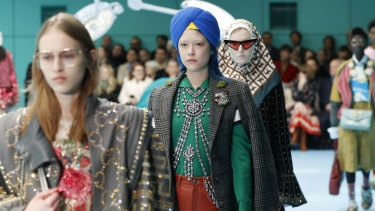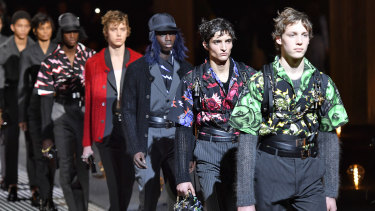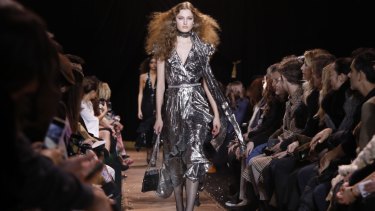When Paris-based luxury conglomerate LVMH announced its new partnership with Stella McCartney last month, many of the specific details were kept under wraps, but one of the biggest – specifically what made the eco-conscious, London-based fashion designer an attractive partner in the first place – was not one of them.
"A decisive factor was that she was the first to put sustainability and ethical issues on the front stage, very early on, and built her house around these issues," LVMH Chairman and CEO Bernard Arnault said in the announcement. "It emphasises LVMH Group's commitment to sustainability."
Sustainable trailblazer … Stella McCartney and models.
That move came on the heels of last month's Ralph Lauren announcement of a slate of ambitious do-gooder goals including using 100 per cent sustainably sourced key materials by 2025, increasing female representation in factory management by 25 per cent in the same time frame, and having greenhouse gas reduction targets in place by the end of next year.
The month before that, it was French luxury group Kering – a partner in McCartney's label until early last year – making headlines with the announcement that its fashion houses (Gucci, Balenciaga and Saint Laurent among them) would only hire models age 18 and older for its runway shows starting next year. Also in May, Prada and the Humane Society issued a joint statement declaring that the Italian luxury group's stable of brands would not use animal fur from the spring and summer 2020 women's collections onward, making it the latest in a rapidly growing list of high-profile luxury labels to stop using fur including Michael Kors, Coach, Burberry and Chanel (in the latter half of 2018 alone).
What's behind the fashion industry's Great Awokening? Why have these traditional standard bearers of aspirational luxe – the same companies that for decades have tried to convince consumers they could never be too thin, too rich or have too many pretty things – seemingly reversed course? While some of the shift is obvious – top-down forces such as recently passed laws (fur-sale bans, for example, have been passed in West Hollywood and Los Angeles and a statewide fur ban is currently under consideration, and in 2017 France passed a law requiring all models to obtain a doctor's certification of their physical health) – much more of it seems to be bubbling up from below.
Gucci is one of several luxury brands to go fur-free in the past two years.Credit:AP
Carry Somers, who co-founded the UK-based Fashion Revolution organisation in the aftermath of the 2013 Rana Plaza fire in Bangladesh (with more than 1100 killed, it ranks as the deadliest disaster in the history of the garment industry), says her group's efforts at encouraging transparency – particularly via its annual survey of top global fashion brands – have started to pay off.
The Rana Plaza disaster in 2013 forced many fashion brands to examine their supply chains.Credit:Reuters
The 2019 Fashion Transparency Index, which ranked Adidas, Reebok and Patagonia in a three-way tie for the most transparent of 200 global brands surveyed, revealed some interesting shifts, Somers said. "[The survey] has really opened up the conversation among the biggest fashion brands," she said. "We've found brands that weren't disclosing anything at all [now doing so] – like Chanel, which this year published its first report. There's not much in it, but it's a start. A great change we've seen is in publishing factory lists; that's something we've been specifically asking brands to do and two years ago only 12.5 per cent of brands were publishing [a list of] their first-tier factories and, this year, that's gone up to 35 per cent."
Somers cites the influence of a changing demographic. "It's definitely a generational thing," she said. "The younger kids are doing climate drives for schools, and we've seen an [increased embrace of] veganism over the last few years that's been really incredible. People have been calling for change because they want to see better policies and practices [in place] for brands.
Prada is also phasing out fur.Credit:First View/Cover Images
"This latest wave has to do with consumers' changing attitudes toward animals, this new drive for transparency, what's now available on the internet for people to see and the generation coming up that has the buying power. When Gucci announces [it is going fur-free] on Instagram, and Prada and Versace announce [going fur-free] on Instagram, I think they're looking to reach Gen Z … The buying power of that generation is going to be so much bigger than the boomers', and they know that that consumer cares about these issues – sustainability (and) animal welfare."
The ‘Who made my clothes?’ campaign has been one of the successes of the Fashion Revolution movement.
Studies of the post-millennial Gen Z demographic (those born in the late 1990s and early 2000s) support Smith's assessment. According to Cone Communications' 2017 Gen Z corporate social responsibility study, by next year Gen Z will account for 40 per cent of global consumers, with a full 94 per cent of Zs surveyed believing that companies should address social and environmental issues. (By comparison, 87 per cent of millennials and 83 per cent of Gen Xers felt that way.) The Cone study also found that 89 per cent of Gen Z respondents said they'd rather buy from a company that was addressing social or environmental issues over one that wasn't, and that nearly half of this mobile-first generation reports spending 10 hours a day online.
"Social media plays a huge role," said Summer Rayne Oakes, a model, environmental activist and author who has been calling for transparency in the fashion industry for over a decade.
In the public’s perception, Generation Z has morphed from apathetic to activist.Credit:AAP
"More so than ever, people and [non-governmental organisations] can use the power of social media to 'shame' companies for values that don't align with their values. What are the practices that are contentious and that would be a social media liability? People are far more outspoken now – from the lack of diversity seen in Victoria’s Secret to the sexual abuse happening in the fashion and entertainment world."
For every one person who asks [who made their clothes], the brands take that as representing 10,000 people that think the same way.
But designer Tracy Reese dismisses the notion that fashion brands are getting woke as a way to woo the Zs, at least in her case. "My average customer is about 40 years old," she said, "so [Gen Z] is not my customer – not that they might not grow into my customer at some point … As for why now? It's because there is a great sense of urgency to change how we're working; to recognise that how we're currently working is not healthy and it's not sustainable – as in it can't last – and that we can't just use up all these resources and go on and on forever," she said. "If we don't make dramatic change in the next 10 years then we won't survive.
"I think the companies that aren't recognising that, that aren't making dramatic changes in their sourcing and their supply chains, they've got their heads buried in the sand."
Michael Kors has also stopped using fur in its collections.Credit:RICHARD DREW
Kering's chief sustainability officer, Marie-Claire Daveu, echoes that sentiment. "Customers are [getting] more and more involved in what brands are doing and they're asking more questions about sustainability – both environmental and social [sustainability] – as well as animal welfare … I think now most brands understand that thinking about sustainability is not an option, it's a necessity."
While the flurry of recent pronouncements by luxury fashion brands trying to do the right thing has generated positive coverage – not to mention reframed the notion of what, exactly, luxury means in the era of the woke wardrobe – it has barely begun to address the industry's biggest, dirtiest secret of all: the exploitative use of cheap foreign labour. It's on this front that Fashion Revolution's Somers says demanding supply-chain transparency is crucial.
"[Transparency] really makes a difference to the workers on the ground because it means issues get remedied much faster," she said. "And it's also really good for the brands because it helps protect them. If one of their suppliers has contracted to a factory that shouldn't be making their clothes and they're found not to be compliant, they can say, 'They're not a registered supplier and shouldn't have been making the clothes.' It should be a win-win. I don't know why all brands aren't doing it."
The most important catalyst to that change, Somers says, isn't a single demographic but a single question.
"As consumers we really have power over these brands, we can use our voice and our power to bring about change – and we really need to do that," she said. "So asking the question, 'Who made my clothes?' is really powerful. I've been told that for every one person who asks [that question], the brands take that as representing 10,000 people that think the same way but can't be bothered to do anything about it."
Los Angeles Times
Source: Read Full Article






